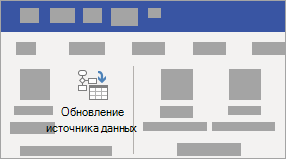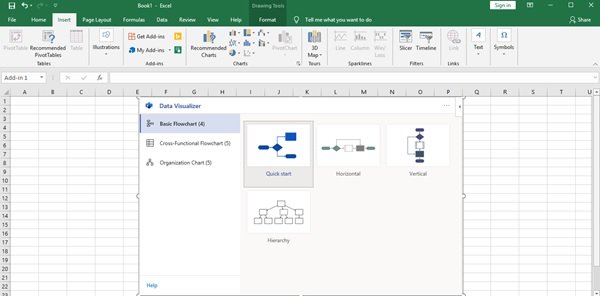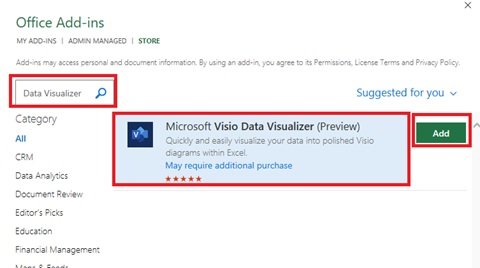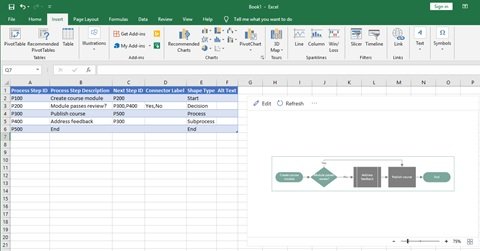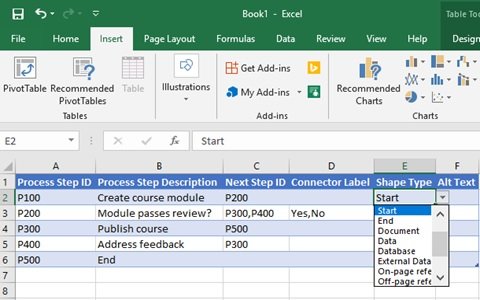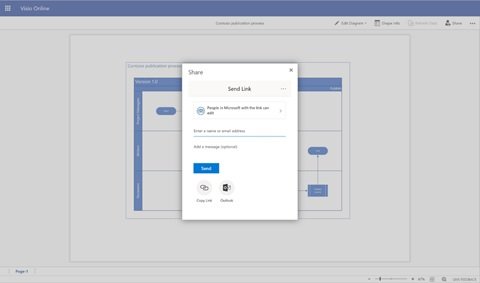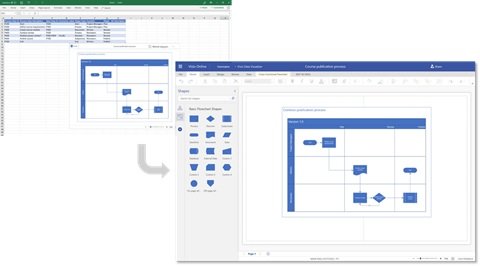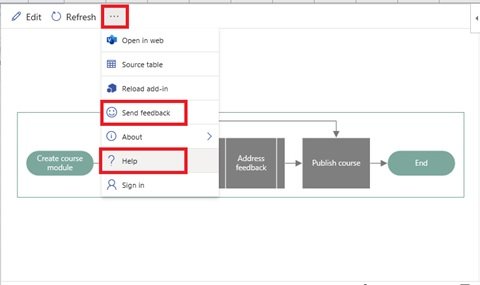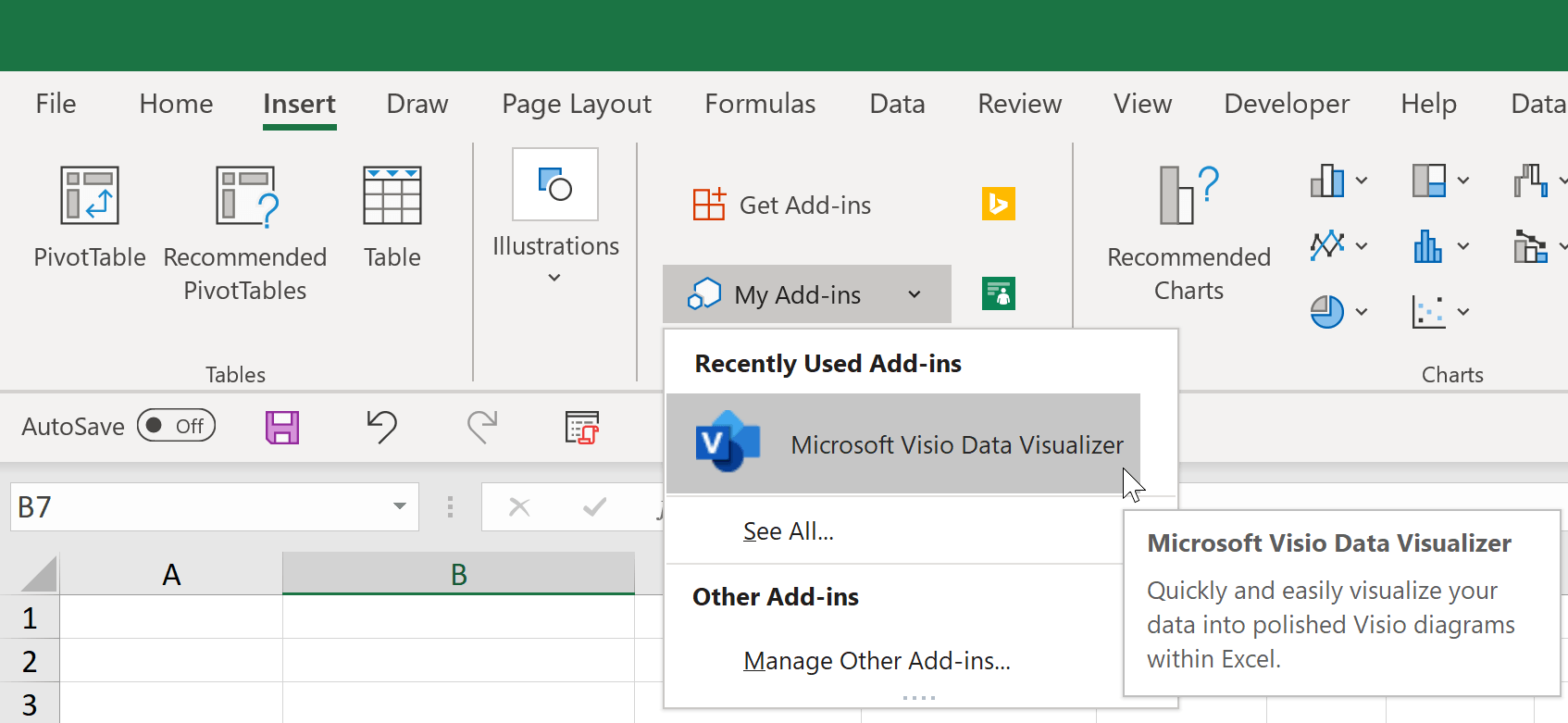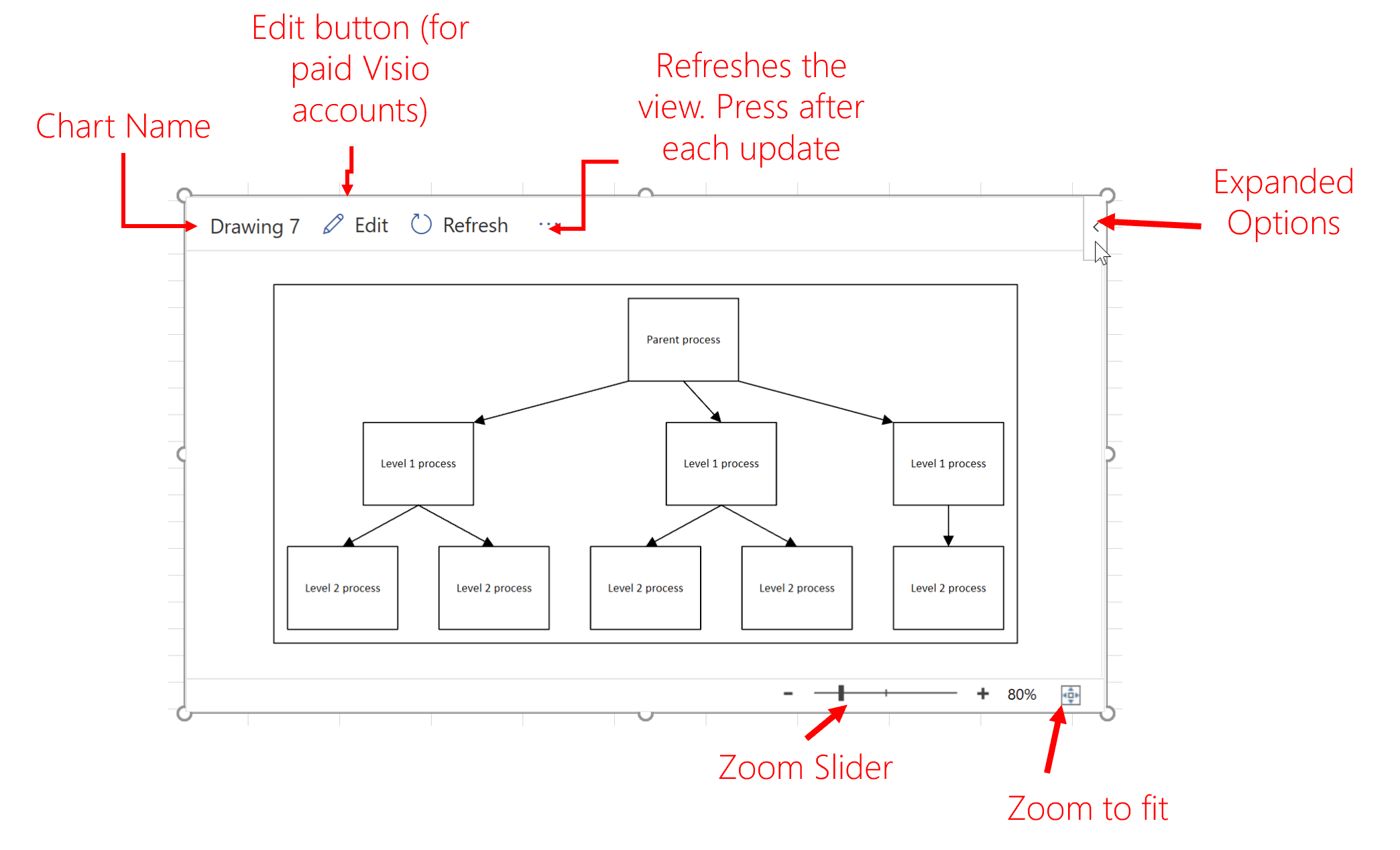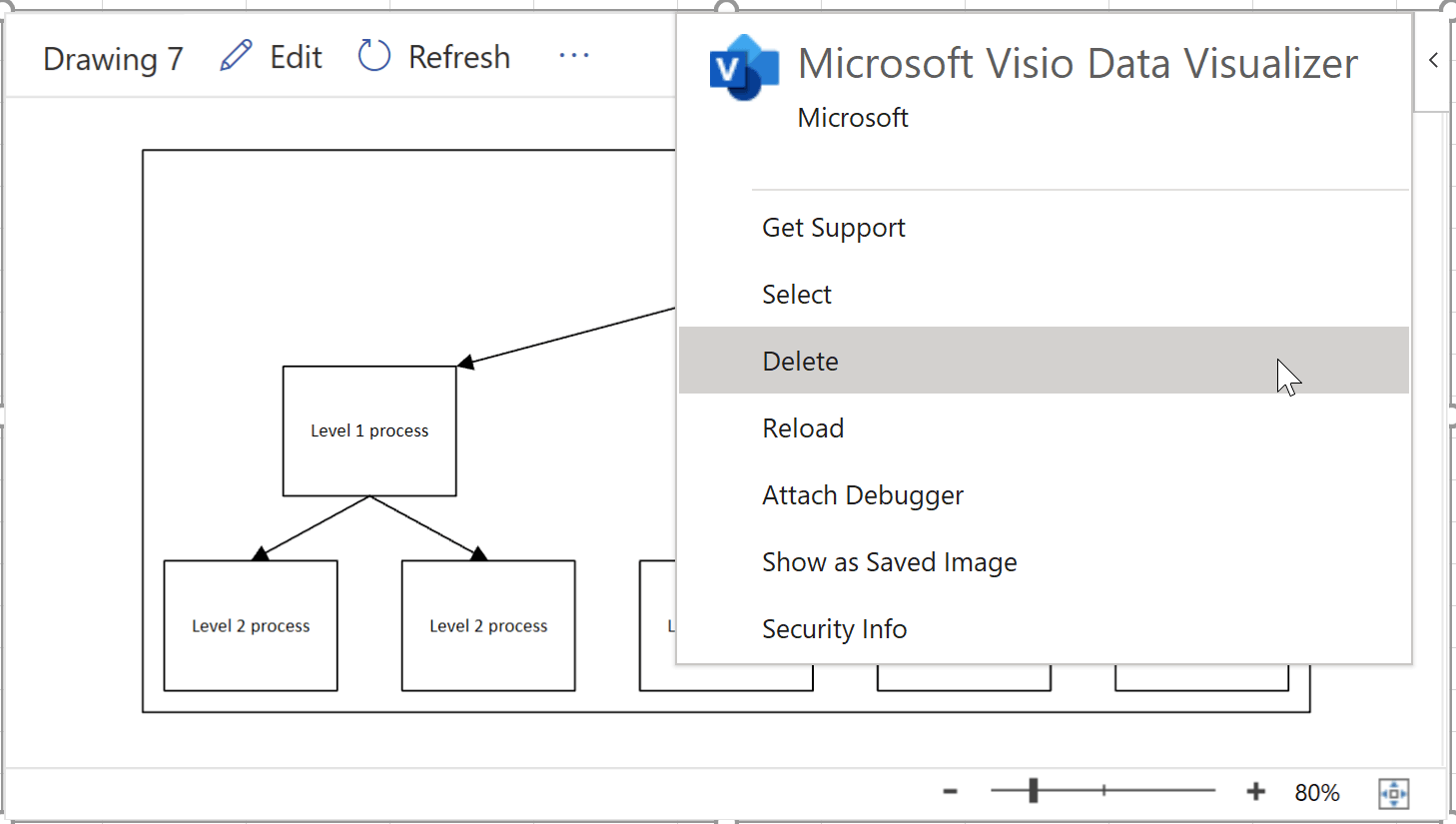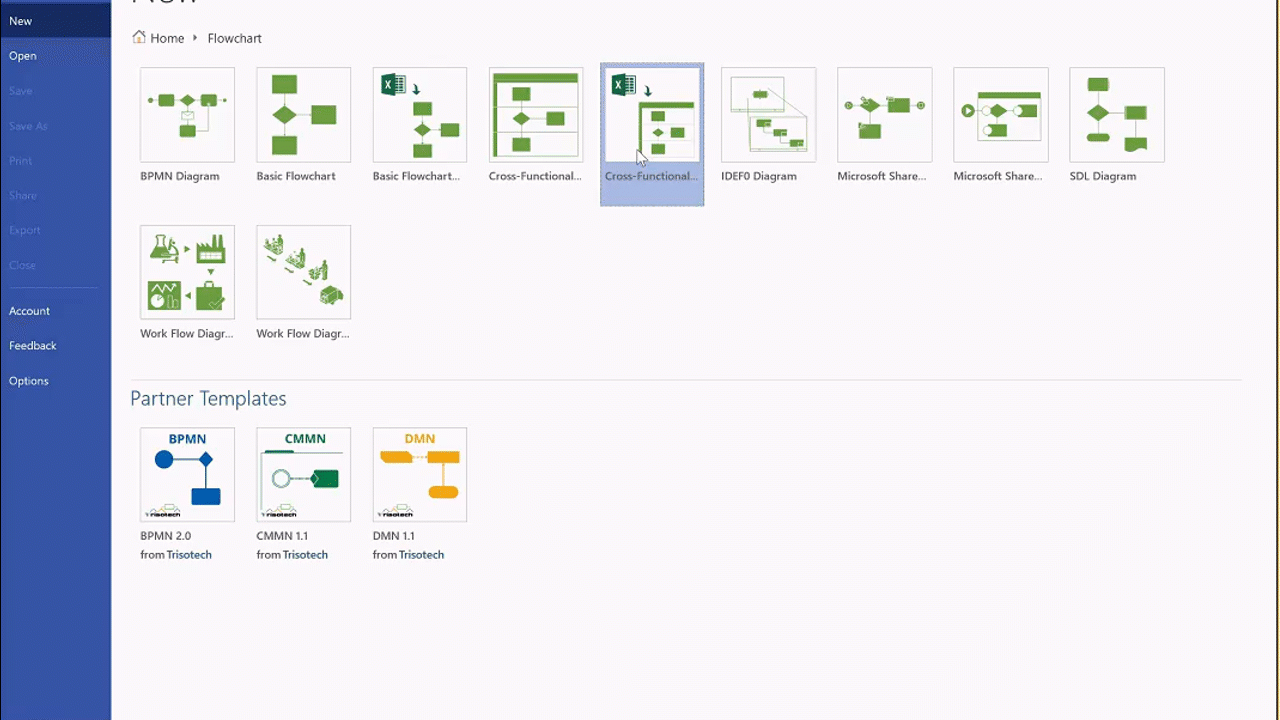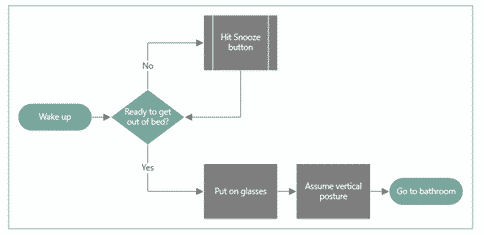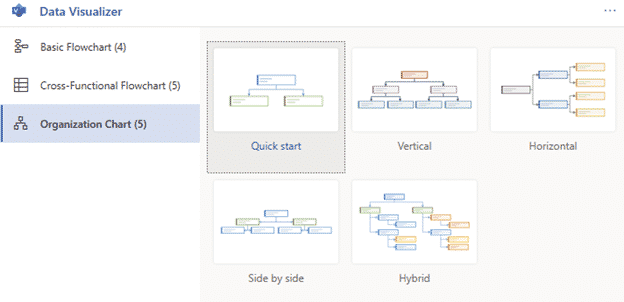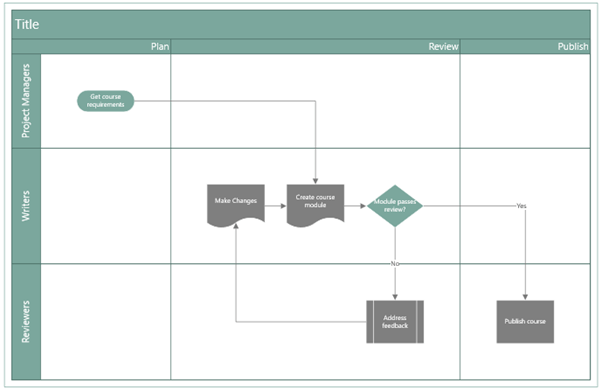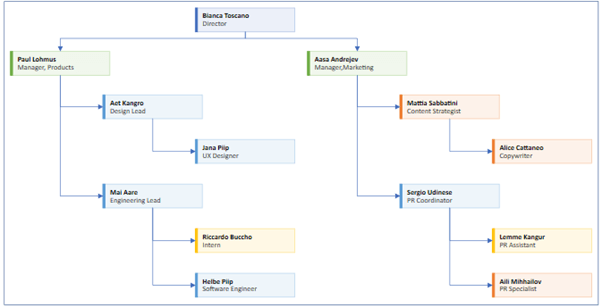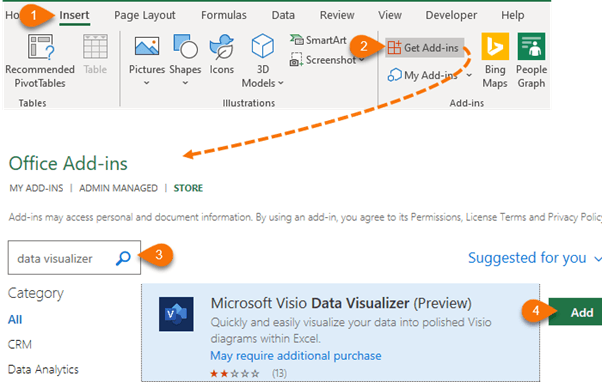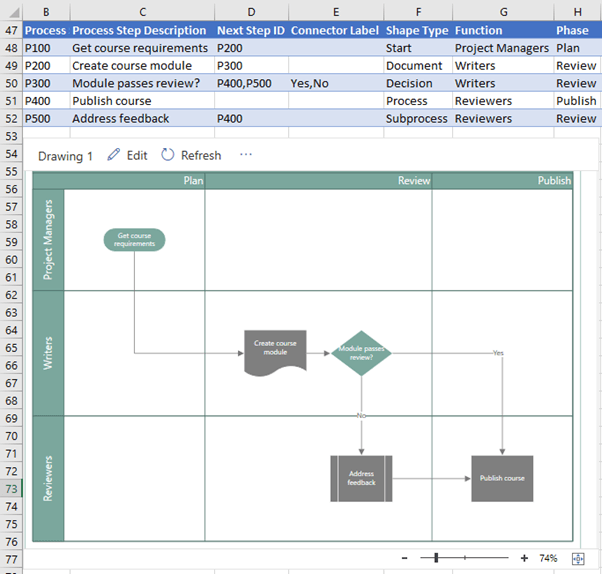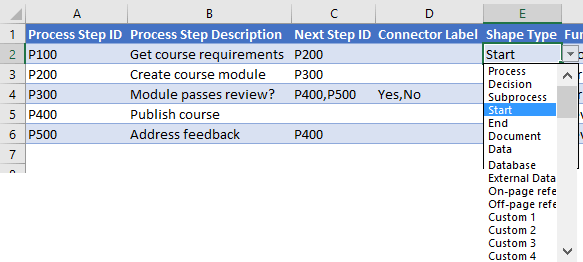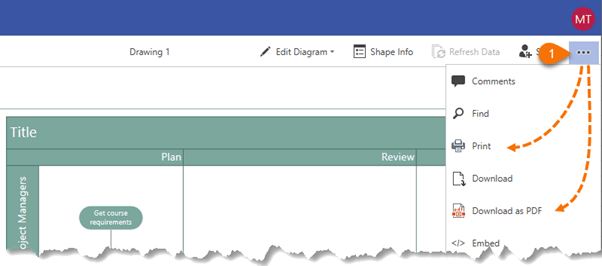Создавайте потрясающие высококачественные схемы с помощью надстройки Визуализатора данных Visio для Excel с помощьюРабочей или учебной учетной записи Microsoft 365.
Вы можете создавать базовые блок-схемы, кроссфункциональные блок-схемы и организационные диаграммы. Диаграммы создаются автоматически из данных в книге Excel. Если вы измените схему в Visio, изменения синхронизируются обратно с Excel.
Это означает, что вам не нужна подписка на Visio для создания потрясающих схем в Excel. Просматривайте, печатайте схемы и делитесь ими с другими пользователями бесплатно в веб-версии Visio. Для дополнительных возможностей редактирования требуется подписка на Visio (план 1) или Visio, план 2.
Примечание: Надстройка Визуализатора данных Visio поддерживается на всех языках, поддерживаемых Веб-приложение Visio. Полный список языков показан в конце этой статьи.
Начните с надстройки Визуализатора данных Visio
Надстройка «Визуализатор данных» доступна для Excel на ПК, Mac и в браузере сMicrosoft 365 #x2 .
(Если у вас есть только личнаяучетная запись Майкрософт, то есть hotmail.com, live.com, outlook.com или msn.com, вы по-прежнему можете опробовать части надстройки Визуализатора данных без входа. Это просто означает, что доступные вам функции несколько ограничены. Дополнительные сведения см. в статье Надстройка визуализатора данных предназначена для Майкрософт 365 рабочих и учебных учетных записей.)
-
Откройте Excel и создайте пустую книгу.
-
Сохраните книгу в OneDrive или SharePoint расположении для удобного общего доступа и оптимального взаимодействия. Вы также можете сохранить файл локально на компьютере.
-
Убедитесь, что в книге выбрана пустая ячейка.
-
Выберите Вставить > получить надстройки или надстройки. В хранилище надстроек Office найдите «Визуализатор данных», а затем нажмите кнопку Добавить. Если появится сообщение безопасности, касающееся надстройки, выберите Доверять этой надстройке.
-
Войдите с учетной записью, связанной с рабочей или учебной подпиской Microsoft 365, или нажмите кнопку Войти позже.
В надстройке больше не поддерживается вход вручную («ADAL»). Но мы автоматически обнаруживаем вашу личность и войдите в систему. Если нам не удается войти в систему, это означает, что ваша версия Excel не работает с надстройкой. Это можно исправить с помощьюExcel в Интернете или обновления до Excel для Microsoft 365.
Примечание: Когда вы вошли в систему, вы открываете возможности в Веб-приложение Visio, такие как печать, общий доступ и просмотр в браузере. Для использования этой надстройки не требуется подписка Visio, но если она у вас есть, вы также сможете вносить изменения в схему.
Если появится запрос на разрешения, выберите Разрешить.
В качестве альтернативы описанной выше процедуре вы можете скачать готовые шаблоны надстроек, чтобы приступить к работе в Excel:
Изменение связанной с данными таблицы для настройки схемы
-
Выберите тип схемы, а затем выберите шаблон, с которым вы хотите работать. При этом вставляется пример схемы и связанная с данными таблица. Этот процесс может занять минуту. Шаблоны поставляются с различными вариантами макета и темы, которые можно дополнительно настроить в Visio.
-
Если вы вошли в систему, схема сохраняется в виде Visio файла в расположении OneDrive или SharePoint. Если вы не вошли в систему, схема является частью книгиExcel. Вы всегда можете создать файл Visio, выполнив вход.
-
Чтобы создать собственную схему, измените значения в таблице данных. Например, можно изменить отображаемый текст фигуры, типы фигур и многое другое, изменив значения в таблице данных.
Дополнительные сведения см. в разделе Взаимодействие таблицы данных со схемой визуализатора данных ниже и выберите вкладку для своего типа схемы.
-
Добавление или удаление фигур для шагов или людей путем добавления или удаления строк в таблице данных.
-
Соединяйте фигуры, чтобы спроектировать логику схемы, введя идентификаторы соединенных фигур в соответствующем столбце таблицы для типа схемы.
-
После изменения таблицы данных выберите Обновить в области схемы, чтобы обновить визуализацию.
Примечание: Если возникла проблема с исходной таблицей данных, появится средство проверки данных с инструкциями по ее устранению. После изменения таблицы выберите Повторить в средство проверки данных, чтобы убедиться, что проблема устранена. Затем вы увидите обновленную схему.
Советы по изменению таблицы данных
-
Сохраните книгу Excel (если вы работаете в клиенте Visio ) и регулярно обновляйте .
-
Сначала рассмотрите возможность набросать логику схемы на бумаге. Это может упростить преобразование в таблицу данных.
Просмотр, печать и предоставление общего доступа к схеме Visio
Вы можете открыть блок-схему Визуализатора данных в Веб-приложение Visio для просмотра, печати или совместного использования схемы с другими пользователями. Инструкции:
-
Чтобы просмотреть схему за пределами Веб-приложение Visio, выберите многоточие (. .) в области схемы и выберите Открыть в Интернете.
Примечание: Если вы еще не вошли в систему, вам будет предложено войти с помощьюMicrosoft 365 #x1 .* Выберите Войти , а затем Выберите Разрешить или Принять в любых запросах на разрешение.
-
После создания файла Visio выберите Открыть файл.
-
В Веб-приложение Visio выберите многоточие (. . .) > печать для печати схемы.
-
Чтобы предоставить общий доступ к схеме, нажмите кнопку Поделиться , чтобы создать ссылку или ввести адреса электронной почты пользователей, которым вы хотите поделиться.
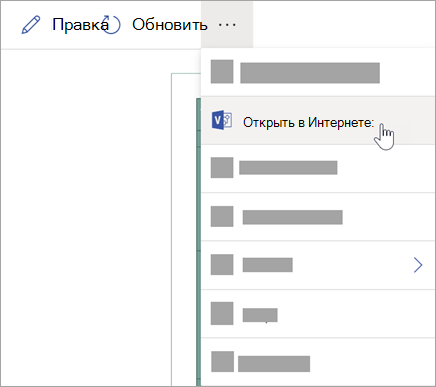
Изменение схемы с помощью подписки Visio
Если у вас есть подписка на Visio, вы можете сделать больше с помощью схемы. Добавьте текст или изображения, примените темы оформления и внесите другие изменения для настройки схемы.
Простое редактирование с помощью Веб-приложение Visio
Используйте Веб-приложение Visio для базового редактирования в браузере, например для изменения тем, изменения макетов, форматирования фигур, добавления текстовых полей и т. д.
-
В области схемы в Excel выберите Изменить
.
Примечание: Если вы еще не вошли в систему, вам будет предложено войти с помощью Майкрософт 365 или Microsoft 365 рабочей или учебной учетной записи. Выберите Войти , а затем — Разрешить или Принять в запросах на разрешение.
-
Внесите изменения в схему в Веб-приложение Visio.
Действие
Использование
Добавление и форматирование текста
Параметры шрифтадомашней >:
Дополнительные сведения см. в разделе Добавление и форматирование текста.
Изменение темы
Проектирование > тем
цвета темы
«Дизайн >»Дополнительные сведения см. в разделе Применение темы или цвета темы.
Изменение макета схемы
Макет
>Дополнительные сведения см. в разделе Изменение макета схемы.
Если вы хотите добавить или изменить фигуру, сохраняя синхронизацию исходных данных, измените схему с помощью классического приложения Visio. Такие изменения, внесенные в Веб-приложение Visio, не могут быть синхронизированы с исходным файломExcel.
-
Завершив редактирование схемы, вернитесь к файлуExcel и выберите Обновить
, чтобы просмотреть изменения.
Расширенное редактирование с помощью приложения Visio
Используйте классическое приложение Visio для расширенных изменений, таких как добавление новых фигур, изменение соединений и другие изменения структуры схемы. Приложение Visio поддерживает двусторонную синхронизацию, поэтому все внесенные изменения можно синхронизировать обратно с книгой Excel, где можно увидеть изменения схемы после обновления.
Примечание: Для редактирования в приложении Visio требуется Visio, план 2 подписка.
-
В области схемы в Excel выберите Изменить.
-
Сохраните и закройте файл Excel.
Для редактирования в приложении Visio и успешной синхронизации изменений необходимо закрыть файл Excel с таблицей данных и схемой.
-
В Веб-приложение Visio выберите Изменить в классическом приложении на ленте.
-
Нажмите кнопку Открыть , чтобы подтвердить. Если появится предупреждение системы безопасности с вопросом, является ли этот файл Visio доверенным документом, выберите Да.
-
Внесите изменения в схему в приложении Visio.
-
По завершении выберите контейнер схемы, чтобы открыть вкладку Конструктор средств данных на ленте, а затем выберите Обновить исходные данные.
Примечание: Если вы попытаетесь обновить исходные данные и связь с данными Visio будет нарушена, Visio предложит выполнить повторное связывание. Выберите область схемы в Visio и на вкладке Конструктор средств обработки данных выберите Повторное связывание исходных данных. Перейдите к книге Visio с исходной таблицей, выберите Повторное связывание, а затем снова обновить исходные данные .
-
Теперь, когда данные синхронизированы с книгой Excel, сохраните файл Visio, желательно в том же расположении, что и файл Excel.) Закройте файл Visio.
-
Откройте файл Excel и нажмите кнопку Обновить в области схемы, чтобы просмотреть изменения.
Примечание: При возникновении конфликта обновления можно обновить схему. Вы потеряете внесенные изменения, но все изменения форматирования фигур или соединителей внутри контейнера сохраняются.
Microsoft 365 подписчики, у которых есть Visio, план 2, могут использовать шаблоны визуализатора данных для получения более сложных функций построения диаграмм, например перечисленных ниже. Дополнительные сведения см. в статье Создание схемы визуализатора данных :
-
Создание схемы с помощью пользовательских наборов элементов
-
Создание подпроцессов
-
Оживите схему с помощью графики данных
-
Двусторонняя синхронизация между данными и схемой
Взаимодействие таблицы данных со схемой визуализатора данных
Каждый столбец таблицы однозначно определяет важный аспект блок-схемы, который вы видите. Ознакомьтесь со справочными сведениями ниже, чтобы узнать больше о каждом столбце, а также о том, как он применяется и влияет на блок-схему.
Число или имя, идентифицирующее каждую фигуру на схеме. Этот столбец является обязательным, и каждое его значение в таблице Excel должно быть уникальным и не пустым. Это значение не отображается на блок-схеме.
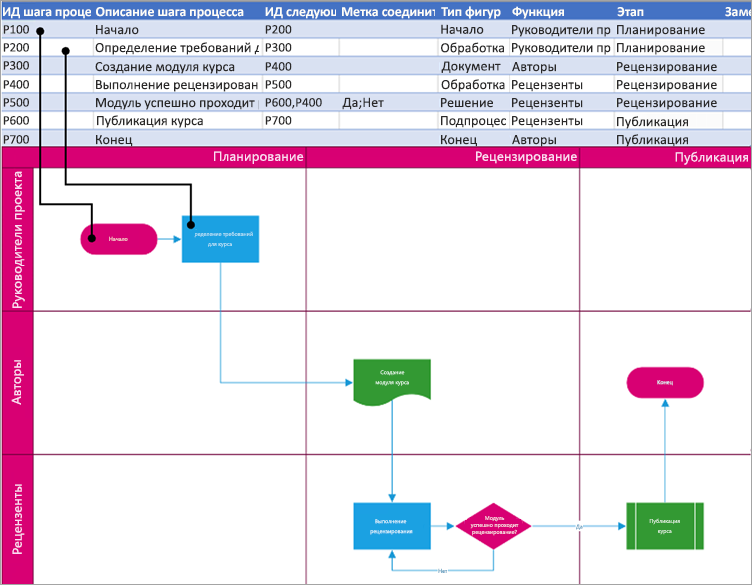
Это текст фигуры, видимый на схеме. Описывать, что происходит на этом этапе процесса. Также рекомендуется добавить аналогичный или более описательный текст в столбец Замещающий текст.
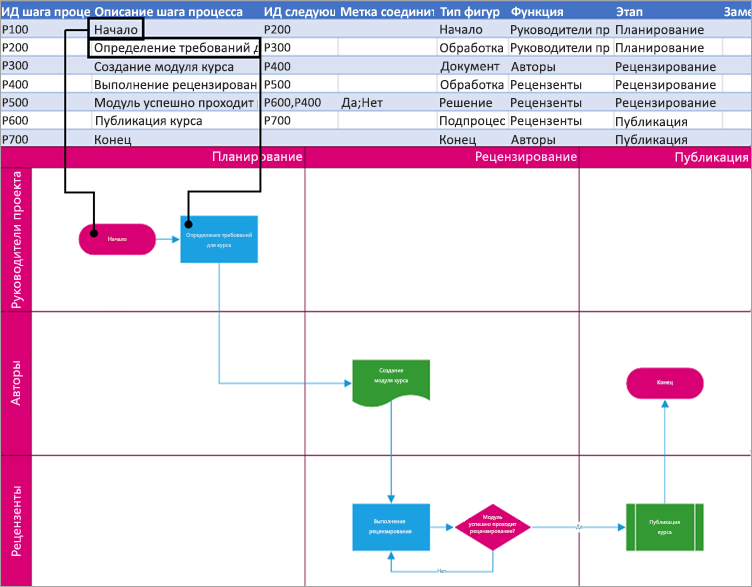
Это идентификатор шага процесса, соответствующий следующей фигуре в последовательности. Фигура ветвления имеет два следующих шага и представлена числами, разделенными запятыми, например P600,P400. Следующих шагов может быть и больше двух.
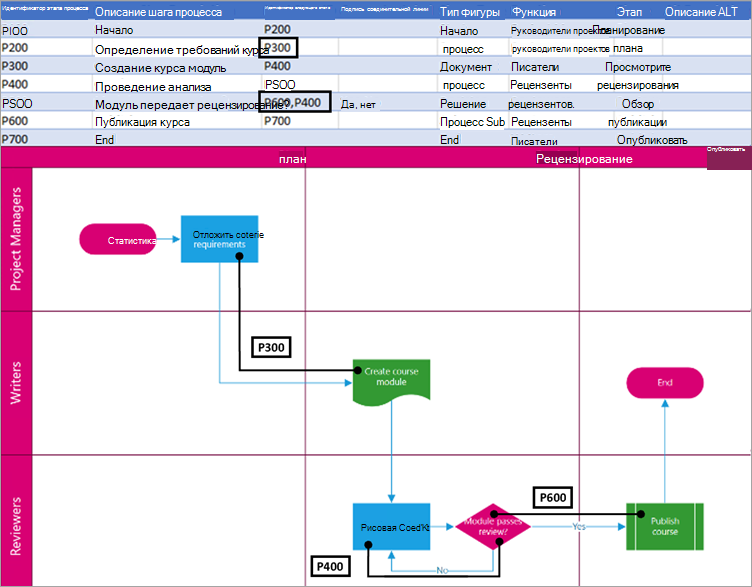
Для фигур ветвления метки соединителя представляются в виде текста, разделенного запятой, например Да, Нет. Да соответствует P600 и No соответствует P400 в примере. Метки соединителя не требуются.
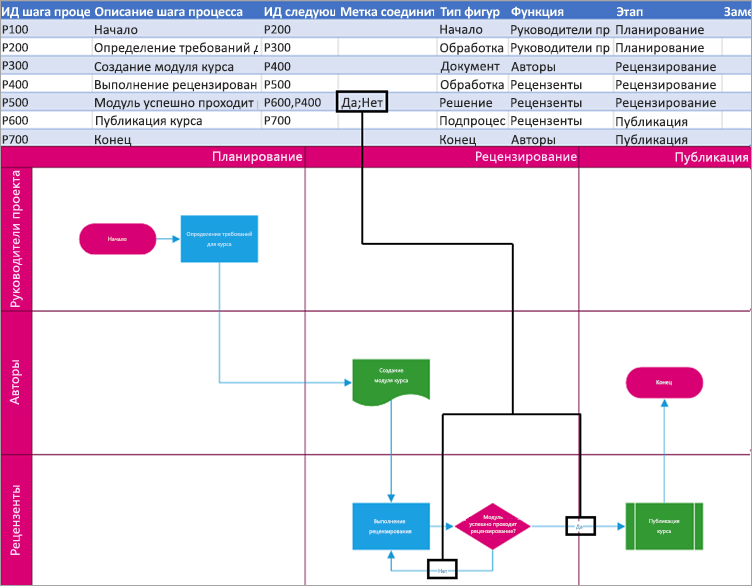
Функция (или дорожка), к которой принадлежит каждая фигура. Используйте столбцы Функция и Этап для организации различных заинтересованных лиц в блок-схеме. Этот столбец относится только к кросс-функциональной блок-схеме и не включен в схему блок-схемы «Базовый».
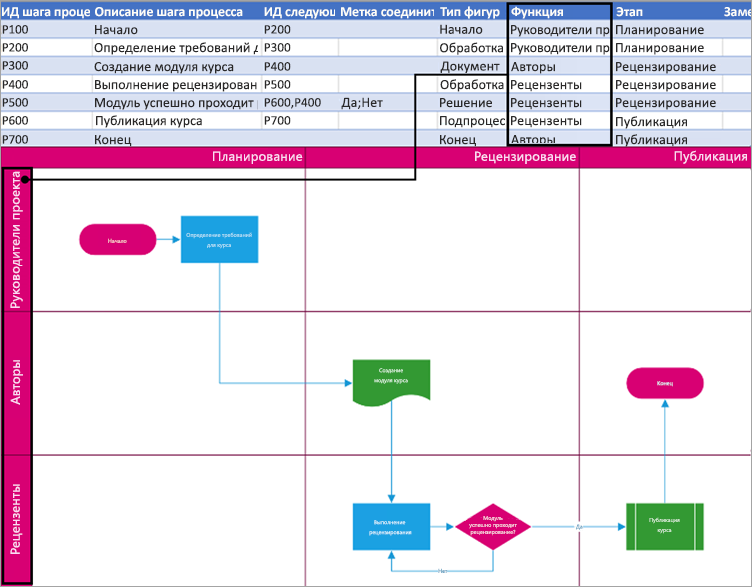
Этап (или временная шкала), к которому принадлежит каждая фигура. Используйте столбцы Функция и Этап для организации различных заинтересованных лиц в блок-схеме. Этот столбец относится только к кросс-функциональной блок-схеме и не включен в схему блок-схемы «Базовый».
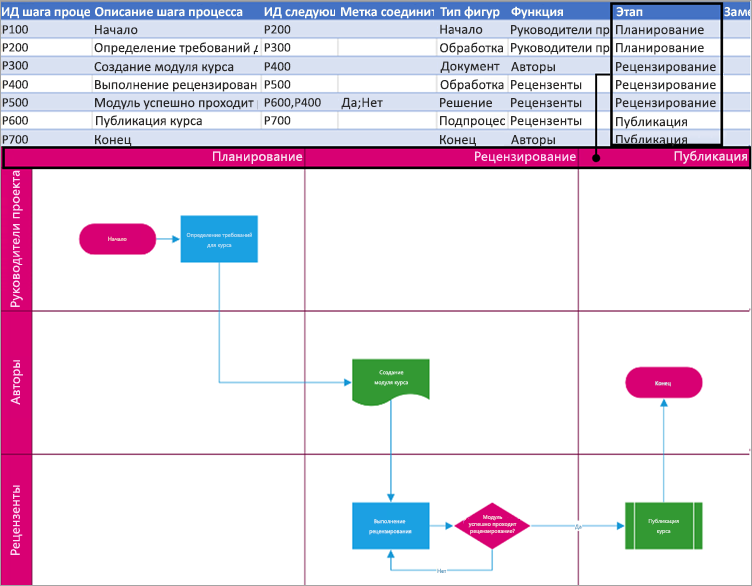
Замещающий текст используется средствами чтения с экрана, чтобы помочь лицам с нарушениями зрения. Вы можете просмотреть замещающий текст, введенный как часть сведений о фигуре. Ввод описательного замещающего текста не требуется, но рекомендуется.
Каждый столбец таблицы однозначно определяет важный аспект организационной диаграммы, который вы видите. Ознакомьтесь со справочными сведениями ниже, чтобы узнать больше о каждом столбце, а также о том, как он применяется и влияет на схему.
Число, определяющее каждого сотрудника в организационной диаграмме. Этот столбец является обязательным, и каждое значение в таблице Excel должно быть уникальным и не пустым. Это значение не отображается на схеме.
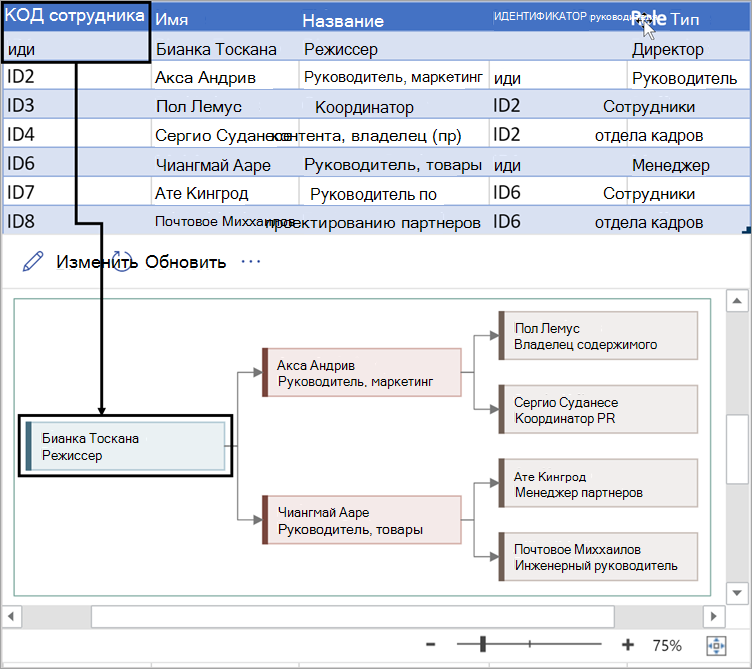
Введите полное имя сотрудника, которого вы хотите связать с идентификатором сотрудника. Этот текст отображается на схеме в виде текста фигуры.
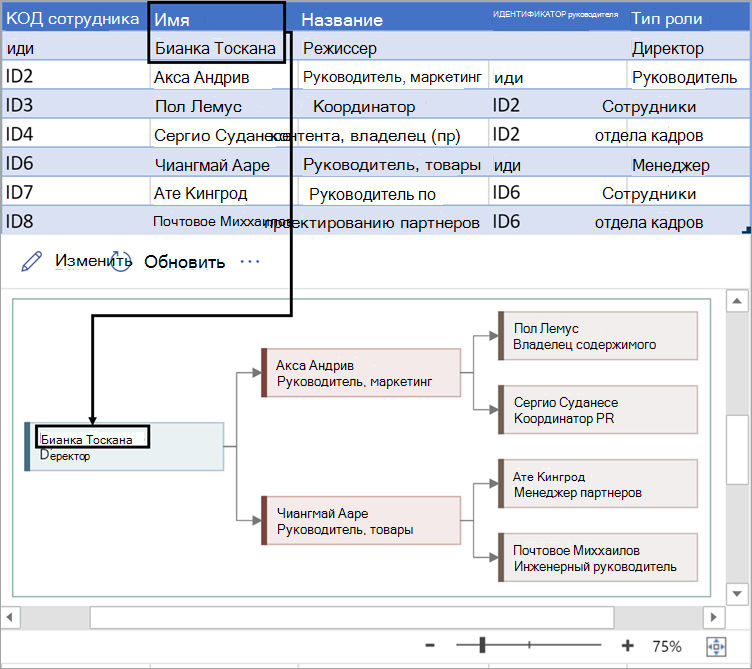
Укажите дополнительные сведения для сотрудника, введя должность или роль. Этот текст отображается в фигурах схемы под именем сотрудника.
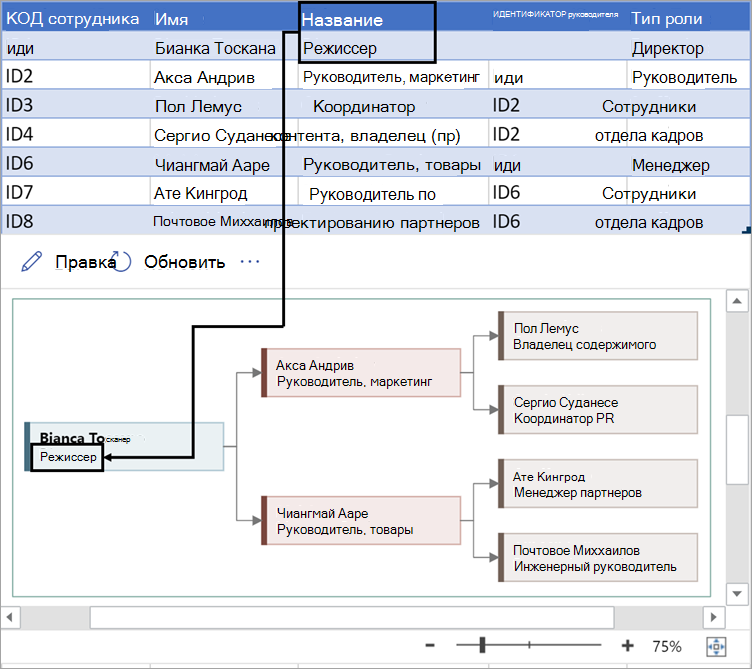
Чтобы создать структуру организационной диаграммы, используйте этот столбец для идентификации руководителя каждого сотрудника. Вы можете оставить его пустым для тех, кто никому не отчитывается. Вы введете соответствующий идентификатор сотрудника из первого столбца. Вы также можете разделить несколько менеджеров с помощью запятой.
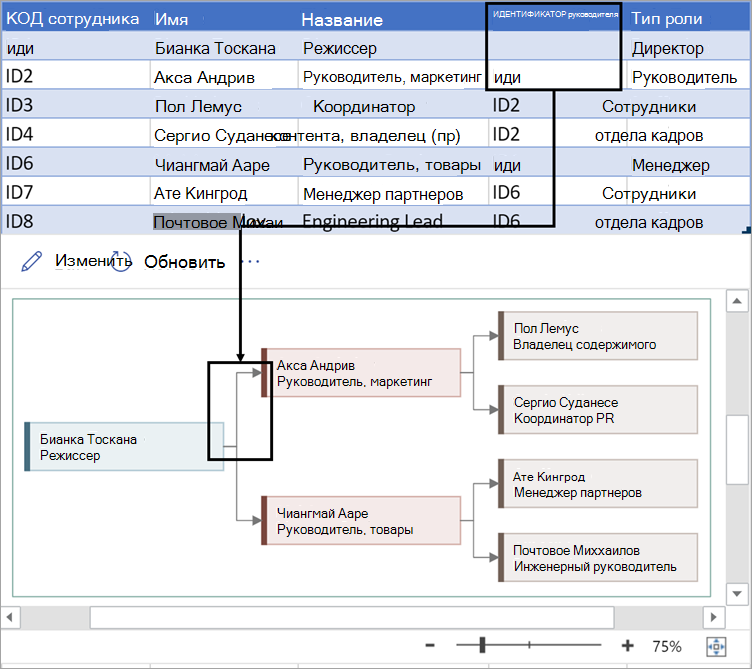
Организационные диаграммы в надстройке поставляются с разными типами ролей. Выберите поле в столбце Тип роли, чтобы выбрать роль, которая лучше всего описывает сотрудника. Это приведет к изменению цвета фигуры на схеме.
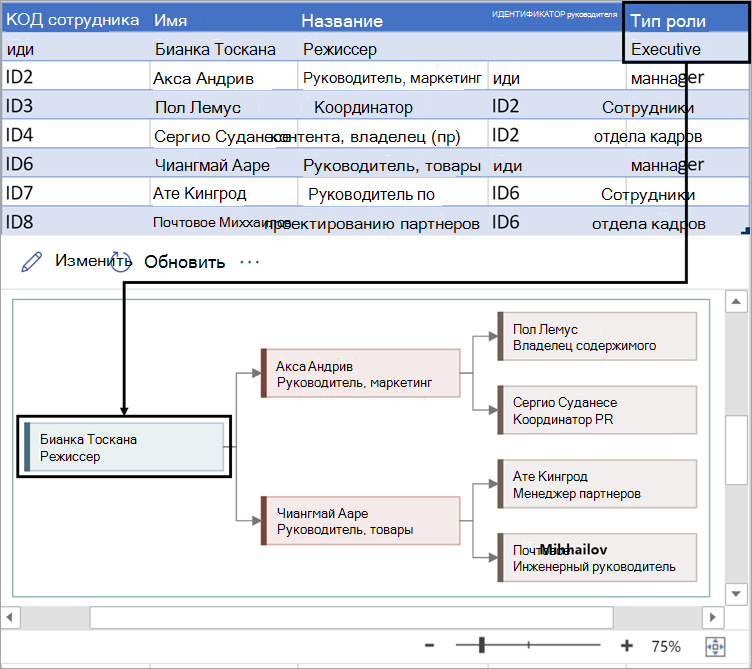
Поддерживаемые языки для надстройки Визуализатора данных
Щелкните подзаголовок, чтобы открыть список:
-
Китайский (упрощенное письмо)
-
китайский (традиционное письмо);
-
чешский;
-
Датский
-
Нидерландский
-
Немецкий
-
Греческий
-
английский;
-
финский;
-
Французский
-
Венгерский
-
Итальянский
-
Японский
-
Норвежский
-
Польский
-
Португальский (Бразилия)
-
Португальский (Португалия)
-
Румынский
-
Русский
-
Словенский
-
Испанский
-
Шведский
-
Турецкий
-
Украинский
См. также
Сведения о надстройке Визуализатора данных для Excel
Microsoft Excel is great for numbers, certainly, it does this job really well. But, if you are looking to present your data in an attractive manner that allows you to easily visualize and analyze it, then this amazing product may lack some features. This calls for some support – try out Data Visualizer add-in for Excel.
The Data Visualizer add-in for Excel is a new arm to Excel which can convert an Excel 365 worksheet into a Visio diagram. This add-in allows the users to automatically create high-quality flowcharts, cross-functional flowcharts, and organizational charts—all the shapes, connections, and data linking—from the data in Excel tables. Users will not need to buy Visio to use the Microsoft Visio Data Visualizer in its simple form, just Excel 365 for Windows/Mac or Online. This is one interesting tool and worth trying if you frequently make flowcharts or diagrams.
All you need to get started is an Office 365 subscription—added subscription to Visio is NOT required.
Data Visualizer leverages the best of Excel and Visio; you enter data into an Excel workbook and Visio creates a diagram automatically. Anyone with an Office 365 subscription can use the Data Visualizer add-in to create Visio diagrams; use the underlying Excel data to modify diagrams; and, view, print, and share diagrams.
This tool is an alternative to the diagram options already in Office which offers limited options and can be quite annoying.
Create Flowcharts & Organizational charts in Excel
The Data Visualizer add-in for Excel is available for:
- Excel on Windows
- Excelon Mac and
- Excel for the web with a work or school account
To install Data Visualizer on any of the above, you will have to follow these steps:
1] Open ‘Excel’ and create a new ‘Blank’ workbook
2] Click ‘Insert’ and then hit ‘Get Add-ins’
3] In the Office Add-ins Store, search for ‘Visio Data Visualizer’ and hit the ‘Add’ button.
4] Now ‘Sign In’ with your account associated with your Office 365 subscription/Microsoft 365 work/ school account.
Note: You do not need a Visio subscription to use the add-in. However, if you have an appropriate Visio license, choose ‘Sign In’ otherwise ‘Sign in later’. In this, there will be few functionalities that get unlocked only after you sign in.
Create diagrams/flowcharts from data in Excel
The Data Visualizer add-in for Excel is powered with a variety of editable sample data tables in Excel. Currently, Data Visualizer offers three types of diagram options including Basic Flowchart, Cross-Functional Flowchart, and Organization Chart. These samples are great to help you get started, they allow the users to:
- Add process steps
- Modify connectors
- Create dependencies
- Insert owners
- And much more
This sample worksheet is just the starting point. You can add more rows, change Shape Types, and switch them around. There are many more choices.
You can even extend this worksheet by adding more columns. These columns do not change the basic Visio diagram but allow you to assimilate the worksheet into the broader analysis.
Users can easily replace the sample data with their own and once done – simply hit ‘Refresh Diagram’ to see the changes sync with the data-linked diagram precisely in the Excel sheet.
View, print, and share your diagrams/flowcharts
Since your Visio diagrams are created online (saved in OneDrive or SharePoint by default) – viewing, printing, and sharing with other Office 365 users becomes unimaginably simple. Whenever you wish to open your diagram in Visio for the web, select Open in web from the ellipses (•••) in the add-in menu bar.
Note: If you’re not signed in yet, you will be prompted to sign in with your Microsoft 365 or Office 365 work or school account. Select Sign in and then Allow or Accept any permission prompts.
After the Visio File is created, select ‘Open File’. From here:
- To print – In Visio for the web, select the ellipses (. . .) > Print to print your diagram.
- To share – Select the ‘Share’ button to create a link or to enter the email addresses of those you want to share with.
Customize & edit diagrams/flowcharts using Data Visualizer add-in
The ‘Edit’ button doesn’t work for those who do not have a separate full Visio license. Without a Visio license, you are stuck with the original color scheme and customizations are restricted.
With Visio Online Plan 1 or Visio Online Plan 2 license, users can do a lot with their Data Visualizer diagrams and make their presentations more interesting. They can add text or images, apply design themes, and make other modifications to customize diagrams in Visio or Visio Online.
The Bottom line – The only diagram alterations possible are from the source worksheet unless you can access the full Visio version.
Help & Support
Users can get additional support and send their feedback directly to Microsoft from the add-in by clicking the ellipses and clicking ‘Help’ or ‘Send feedback’.
Data Visualizer add-in for Excel is worth trying!
You should try the Visio Data Visualizer Add-In for Excel. Open up a sample worksheet and play around with the flowcharts to see how things work.
Source: Microsoft.com.
Microsoft Corporation
Начало работы с надстройкой:
Открыть в Excel Online
Эта надстройка работает со следующими приложениями: Excel 2016 or later on Mac, Excel 2016 или более поздней версии на Windows, Excel on the web.
Если у вас нет вышеуказанного, воспользуйтесь Office.
Как запускать надстройки в Office Online
Вы можете запустить любую надстройку в Office Online. Щелкните здесь, чтобы получить пошаговые инструкции
Introduction
I wanted to let you know about a really cool new add in for Microsoft Excel. This is one of those modern add-ins you can download from the Microsoft store.
This add-in can allow you to easily create hierarchy type process maps and flow charts. The free version creates standalone type charts. The paid version, the one Microsoft would like you to buy, connects you to the online Visio service. The idea is that you can create a process map in Excel, automatically generate an editable Visio file, and then integrate that into Power Point.
Today, I’ll only deal with the *FREE* version.
Microsoft Excel — Visio Data Visualizer Quick Guide
How to install the Microsoft Excel Data Visualizer
You can install Data Visualizer to your Office 365 installation. Go to Insert > Get Add Ins.
Search for «data visualizer.» When you see the Microsoft Excel Data Visualizer tool, select Add.
Once installed, you’ll need to login with your Office 365 Account. To gain access.
Inserting a new Visio hierarchy diagram
To insert a new diagram, go Insert > My Add-ins and select My Add-ins > Microsoft Data Visualizer.
Diagram Types
The are three diagram types available.
These types are as follows: Basic Flow Chart, Cross-Functional Flowchart, and Organization Chart.
Basic Flowcharts
Basic flow charts should be used for general flows. Under the Basic flowchart type there are four options:
- Quick Start — Quick start will create a very simple decision diagram
- Horizontal — Horizontal will create a very basic horizontal flow diagram
- Vertical — Vertical will create a very basic vertical flow diagram
- Hierarchy — Hierarchy will create a very simple top-down hierarchy. It will have less features than the comparable diagrams in Organization Chart section.
Cross Functional Flow Charts
There are five default flowchart types for Cross Functional charts. Sometimes these are referred to as «swim lane» charts. Here are the defaults:
- Quick Start — Quick start creates a multiple phase cross functional flow chart with various elements on it. The layout is a bit random but should be enough to help you keep going.
- Horizontal — Horizontal creates a swin-lane chart with multiple phases. That basically means everything will be laid out in a grid but the flow will be horizontal.
- Horizontal (single phase) — Horizontal (single phase) will look like the prototypical swim lane chart. It won’t have multiple phases crossing on the other axis. The flow is horizontal.
- Vertical — Vertical creates a swin-lane chart with multiple phases. That basically means everything will be laid out in a grid but the flow will be vertical.
- Vertical (single phase) -Vertical (single phase) will look like the prototypical swim lane chart. It won’t have multiple phases crossing on the other axis. The flow is vertical.
Organization Chart
There are five organizational chart types. These charts create hierarchies useful for modeling organizational structures. However, with some additional work, you could adapt the problem to alternate hierarchies. Here are the five chart types:
- Quick Start — This would create a simple bi-level hierarchy
- Vertical — This would create a vertical (root at the top) tri-level hierarchy.
- Horizontal — This would create a Horizontal (root at the left) tri-level hierarchy.
- Side-by-side — This chart would be ideal when you need to organize several people in a hierarchy at the same level. To be honest, I don’t really see a true reason for this one. I would recommend using another type.
- Hybrid — This is the one you’ll most likely be using to model most complex organizations. With this choice, Excel will take care of the layout vis a vis different levels.
Editing a Hierarchy
I won’t go through each type in this guide. However, no matter which type you select, several options are available in each diagram type by editing the Excel table.
Basics of Editing
For the most part, you can edit the following parts of the diagrams: Connections to other Objects, Captions, Object Shape and Color, and Connection Labels.
Editing a Connection
Each object has its own ID. There is usually also another column that includes the potential connections to another object.
The image below shows the object IDs on the left.
Note, this is a basic chart hierarchy example, Next Step ID contains the next items to connect to. Different charts may have a different name, but the concept is the same. To connect to multiple IDs, use a comma.
Editing a Caption
Each diagram allows you to edit one or more captions. In the hierarchy example, you can edit each title by changing the Process Step Description. Again, this column name might change depending upon the chart type selected, but it should be fairly obvious which column holds the information.
Editing an Object Shape and Color
Most diagram options will have a preloaded set of categorical designations. These will change the color and shape of each object. I think some of them follow flow chart norms.
The following example uses an organizational chart layout. In this case, changing Role Type will change the color or shape. If you scroll up, you see the simple hierarchy use the Shape Type column instead.
Editing a Connection Label
You can also edit a connection label in several charts. This will allow you to change the label next to the connection arrow to the next job. If you think of a decision flow diagram, the standard connection labels for a decision are «Yes, No.» You’ll see columns like Connector Label that will allow you to set the label. If you have multiple connections separated by a comma, each comma separated label will be applied to them respectively. (You can see an example of this in the video above.)
Overview of the Visio Flow Chart
This section provides an over view of the actual flow chart. There are multiple buttons on and interactive items on the chart. The image below provides a description of the layout.
Note that you can edit, refresh, change the zoom level and view expanded options.
Edit Button
This button is a bit of a misnomer as you are able to edit the chart on the spreadsheet itself. However, if you have one of those expanded Office 365 licenses (don’t ask me which one, I can barely figure out my current license — all I know is that it doesn’t include Visio), you can actually edi the the file itself as a visio file. That would give you significantly more control over color, fonts, and more.
Again, though, it’s only for paid accounts. From what I understand, it’ll create a visio file store on OneDrive. That file would be separate from the Excel file but embedded.
Refresh Button
After each change to the Excel table, you’ll need to hit Refresh to see the result. I’m told this will be upgraded to automatically refresh. Until the, you’ll be clicking this button a lot.
Zooming
You can zoom in and out using the zoom slider. If you want to reset the zoom, you can select the zoom to fit button.
Expanded Options (Delete Button)
The expanded options menu contains additional support items. It’s also where you can delete the visio chart if you don’t want it anymore. You can also show it as a saved image.
Final Thoughts
Overall I think this is a really cool tool to add. In my video review, I mention that you could use this for much more than organizational hierarchies or flow charts. I could see these being used to create decision trees and modeling conditional probabilities, for instance.
One thing still missing is VBA manipulation. If you wanted to use VBA to create a chart for a user, you’d basically have your macros fill in the required information in the table dynamically. That’s about as much programmatic capability I can see for now.
In addition, «data visualizer» is not a great name. Data isn’t really being visualized in what we could consider a quantitative display. This is more of a concept mapper.
Still, I think this flow chart is pretty cool. What do you think? Would you use it?
Мы рады представить новую функцию «Визуализатор данных» в Visio, которая автоматически конвертирует данные карты процесса из Excel в схемы Visio. Это обновление, доступное для пользователей Visio Pro для Office 365, помогает сократить объем ручной работы и предоставляет бизнес-аналитикам еще больше способов для создания схем процессов в Visio.
Автоматическое создание схем процессов из данных Excel
Схемы не всегда начинаются в Visio. Часто они появляются в виде зарисованных вручную набросков, или — в современном мире данных — в Excel. При помощи визуализатора данных, бизнес-аналитики могут представлять шаги процесса и связанные с ними метаданные в структурированной таблице Excel, и затем быстро визуализировать эту информацию в виде схемы Visio. Сделать это можно, используя готовый шаблон Excel или существующую таблицу собственной разработки. Готовые шаблоны — один для базовых и другой для кросс-функциональных схем — представляют образец сопоставительной таблицы для заполнения метаданными схемы. Таблица включает предопределенные столбцы для номеров шагов процесса, описания, зависимостей, владельца, функции, фазы и многого другого. Также можно дополнять таблицу своими столбцами для соответствия специфическим бизнес-запросам.
Как только таблица заполнена, мастер в Visio помогает завершить оставшиеся шаги по трансформации данных Excel в схему процесса в Visio. При настройке готового шаблона и при создании собственного, мастер помогает отобразить определенные части схемы, такие как дорожки и соединители. Конечная схема связана с таблицей Excel, так что при изменении данных, лежащих в основе процесса, схема будет обновляться автоматически.
Кроме того, аналитики могут сохранять схемы Visio и лежащие в их основе таблицы Excel в едином наборе, используя функцию “Export as a Template Package”. Этот набор может быть использован другими, предотвращая необходимость повторного создания такой же схемы и поощряя согласованность процессов во всей организации.
Вне зависимости от ваших предпочтений — создаете ли вы схему из шаблона или же из своей таблицы — лежащие в ее основе данные Excel перемещаются с соответствующим файлом Visio Pro для Office 365, обеспечивая всей вашей команде доступ к самой актуальной версии схемы.
Запустите бесплатную пробную версию Visio Pro для Office 365, чтобы оценить Data Visualizer прямо сейчас, или же посетите нашу страницу поддержки для получения пошаговых инструкций по созданию схемы процесса из данных Excel.
A new Excel add-in converts an Excel 365 worksheet into a Visio diagram. You don’t need to buy Visio to use the Microsoft Visio Data Visualizer in its simple form, just Excel 365 for Windows/Mac or Online.
It’s an interesting tool and worth checking out if you make diagrams or flowcharts. The add-in inserts example worksheets that you can use as templates for your own needs. We made this simple diagram from a worksheet in just a few minutes.
Change the diagram from the linked worksheet. Change label, add more rows etc and the diagram changes.
Data Visualizer is an alternative to the diagram options already in Office which can be quite annoying and limited.
On the other hand, without an expensive Visio licence, the Data Visualizer diagrams can’t be customized or edited. The color schemes are fixed.
Install
In Excel 365 for Windows, Mac or Online go to the Insert | Office Add-ins and search for ‘Visio Data’. Add ‘Microsoft Visio Data Visualiser’.
Tip: do this from a blank worksheet because the add-in will automatically insert into the current workbook.
After it’s installed, the addin appears in the current worksheet. If you have an appropriate Visio licence, choose ‘Sign In’ otherwise ‘Sign in later’ for most people.
First time with Visio Data Visualizer
Insert a Data Visualizer into a worksheet from Insert | My Addins.
You could try converting an existing worksheet into a diagram but the worksheet has to be in a specific format. It’s a lot easier to start from one of the supplied examples.
Basic Flowcharts
Cross-Functional Flowchart
Organization Chart
Making your own diagrams
Once you’ve chosen your starting diagram, check out the worksheet. This is where you’ll change the supplied example into something you’ll use. Each worksheet is different depending on the selected template.
Some parts of the worksheet are common to all. Let’s look at the Basic Flowchart worksheet.
Each element has a Process Step ID which is like old-fashioned coding line numbers that a BASIC programmer might remember. The defaults are in 100 increments so you can easily insert steps without renumbering, like we have with a new step P250.
Next Step ID tells the add-in where to draw links between steps.
Shape Type is a pull-down list of available shapes/symbols for the diagram.
Some shapes need a Connector Label, e.g. Decision needs labels for Yes/No, Left/Right etc.
Process Step Description is the label inside the Shape.
Alt Text can be added to make the Shapes more accessible.
The sample worksheet is just the starting point. Add more rows, change Shape Types, switch them around … go crazy!
Click the Refresh button to see a revised diagram. The add-in will show any errors like inconsistent Next Step ID’s.
Extend the worksheet
In the real world, you can extend the worksheet to add more columns relevant, things like cost, location, people etc. These columns don’t change the Visio diagram but let you integrate the worksheet into broader analysis. Just for fun, we’ve added two columns to the original worksheet.
Editing
If you don’t have a separate full Visio licence (expensive) the Edit button doesn’t work.
Without a Visio licence, you’re stuck with the original color scheme and no other customizations allowed.
Bottom line: the only diagram changes possible are from the source worksheet, unless you can access full Visio.
Give it a try!
Our best advice is to give the Visio Data Vizualizer a try. Open up a sample worksheet or two and see how it works.
The Office flowchart tool has always been annoying because the arrows between each step aren’t linked (i.e. move a shape and the arrows have to be moved individually).
The Data Visualizer is an interesting alternative.
According to Microsoft, Visio Data Visualizer is available in Excel 365 for Windows or Mac plus Excel Online.
Microsoft have recently released a preview of the Microsoft Visio Data Visualizer for Excel, and if you have not yet tried it … you should! I am sure that it is far more powerful than one might expect because you can create some very useful Visio diagrams without a Visio license! Sure, you do need a Visio license to edit the diagram, but, if you keep your source table updated, then the diagram will automatically update itself. You can now create, update and share process flow diagrams and organisation charts from Excel and add them to Power BI reports!
Reviewing the original Data Visualizer functionality
Until now, the integration of Visio and Excel with the two Process Map templates in Excel or three Excel templates in Visio have been limited to basic and cross-functional flow charts. In both cases, it is necessary to have licences for both Excel and Visio to create and maintain the diagrams.
This feature does include two-way updates, so the user can either update the source table in Excel or the target diagram in Visio, and then refresh the other. Although this capability exists, it is not always necessary to have bi-directional updating and refreshing, and indeed I wrote an article a while ago about using a database as a read-only source for Data Visualizer for Visio Pro for Office 365 – Part 2. By the way, Visio Pro for Office 365 was the original name for Visio Plan 2.
The key feature is that flow charts can be easily created from Excel tables with some specific requirements, such as a column with a unique identifier, and a column that specifies the predecessor or successor unique identifiers. There is a column to specify the shape type (master name) to be used, the text to be applied, and, in the case of cross-functional flowcharts, the swimlane or stage to place the shapes in.
It was always the intention of Microsoft to increase the
diagram types beyond flow charts, and so organization charts became the next
offering in this new add-in for Excel.
The Visio Data Visualizer includes Basic and Cross-Functional Flowcharts, but has added Organization Charts to the list! Simply go to the Microsoft store with the Insert / Add-Ins / Get Add-Ins button, and enter Visualizer as a search string. Then Add the Microsoft Visio Data Visualizer add-in to your Excel environment, trusting it if prompted. You can use the add-in on any blank worksheet tab, but it is advised to first save the Excel workbook to a OneDrive for Business or a SharePoint Online folder before using it because the add-in will automatically save the new Visio document there. You will be prompted with three types of Visio diagrams to create.
- Learn more about using the add-in : Create a diagram in Excel with the Visio Data Visualizer add-in
- Learn more about the add-in capabilities : About the Data Visualizer add-in for Excel
Creating an Organization Chart
Microsoft Visio has had an organizational chart feature for over 20 years, and is used by many companies, and it has a few issues, including not being able to update any hierarchy changes without having to completely re-draw. This new Visio Data Visualizer add-in for Excel, however, can automatically change the structure of the diagram to match the data. This applies to all of the diagram types, not just Org Charts. When a diagram type is selected, a Visio control is added to the Excel worksheet along with a sample source table that is used to generate the diagram.
There are five required columns for an Organization Chart:
- Employee ID Must be unique
- Name The
name is displayed as the first line of text, in a bold font. - Title The
title is displayed as the second line of text - Manager ID The ID of the manager, which must exist in the Employee ID column
- Role Type The
role type is used to colour the shapes by value
You can add extra columns to the table, and they will be added as data rows to each shape, but they will not be displayed on the shapes, unless the Visio document is edited in Visio for Desktop or opened with the Visio for Web in reading view.
The Visio control displays the Visio file name, an Edit button, a Refresh button, and a Show more commands (…) button.
Replacing the sample data with your own
The Source table option selects the current source of the data, which can then be manipulated, if desired. For example, the above organization chart is based on the Table2 table. This can, of course, be edited be adding extra columns or rows. It can also be replaced with a PowerQuery that comes from another data source, and, if the name, eg Table2, is re-applied before the Refresh command is pressed, then the Visio diagram will be updated with the new data.
If you do have a Visio Plan 2 license, then you can edit
the Visio document in Visio for Desktop to update the masters of
the shapes to provide more text and hyperlinks, for example.
I have always thought that using Excel as a data source for Data Visualizer to be a tremendous feature because it allows the Visio developers to spend more time on visualising the data better. In addition, the PowerQuery skills are directly transferable to Power BI. Just one look at the number of data sources available, in Data / Get Data, to generate Visio diagrams from is staggering. These would be read-only diagrams, but if they are automatically updated, then their usefulness is boundless.
- Learn more about PowerQuery : Getting Started with Get & Transform in Excel
Sharing the Visio Diagram with others
One of the Show more commands is to Open in web, which will open a new browser window with the Visio document in reading view. This does have the advantage that any data, and hyperlinks, on a shape can be viewed in the Shape Info window.
There are multiple options in this Show more commands (…) button in the top right corner. One of these options is to view and edit Comments, but notice the many other options that may be available, depending upon permissions, such as Find, Print, Download, Download as PDF and Embed.
- Learn more about Comments and co-working in this article : Work together on Visio drawings.
- Learn more about Print and Download as PDF in this article : Print a Visio diagram on the web.
- Learn more about Embed in this article : Display a Visio Diagram on a Web Page.
The Visio document is given a unique default name, Drawing xx, and is created in the same folder as the Excel workbook. This file name can be edited by users that have a Visio license, and this should be done within Visio for Web before electing to edit in Visio for Desktop.
Integrating with Power BI
One of the really cool consequences of this new add-in is that it is possible to create a Visio document and embed it within a Power BI report without a Visio license. You will only need a Power BI licence to collaborate with others ( see powerbi.com ).
First, create a new Power BI report and get the data
from the Excel table, or from the source of the query that forms the Excel table. This data is then available in Power BI, and normal visuals such
as the Chiclet Slicer, Table and PowerApps visuals can be
utilised, as shown below.
Then simply retrieve the shareable link of the Visio document from the Open in Web option above and paste it into the Visio Visual with the unique identifier field of the query selected. The records will then be automatically mapped to the correct shape in the Visio Visual, and then the shapes can have extra text added to them, or they can be coloured by a numeric value.
Notice how the Power BI visuals, in this case PowerApps, provides the ability to include images, something that the Visio Data Visualizer add-in is not yet capable of providing.
- Watch a short video of the above : https://youtu.be/9SD5eBEn4rY
- Learn more about Visio and Power BI, including a free guide at : Visio Power BI articles
The future of Data Visualizer
This add-in is currently a preview, so I encourage you all to try it and provide feedback in User Voice to impress the Microsoft development team to focus on the features that are important to you.
This add-in is a truly encouraging direction for Microsoft to take, and I hope will expand to include other diagram types, such as network infrastructure, roadmaps, project plans, and more. There are many refinements that I would also make to the add-in before release, but the future of instantly updateable diagrams is looking extremely encouraging.
My last post was about some of the lessons learnt when trying to push Data Visualizer to its limits, but this one has some ways of overcoming these limitations. The main lesson learnt is that DV binds the shapes within the DV container shape, CFF Data Visualizer, and controls some of the ShapeSheet cells that…
Regular readers of my blog will know that I like to use the Data Visualizer (DV) in Visio Plan 2, but I recently tried to help a user who really decided to push it to the limits. In this scenario, there were multiple connections, but with different labels, being created between the same flowchart shapes,…
I am delighted to share the link to my recent demonstration and conversation with fellow MVP Peter Ward about Visio in Teams. We discussed more than just Visio … and I look a bit like Max Headroom! (more…)
I re-vamped some of my content about the Visio Data Visualizer add-in for Excel in my last post, so I thought I should expand a bit more on the Data Visualizer feature in Visio for Desktop (Visio Plan 2) and Excel for Desktop. I have described it in detail in previous posts, but I never…
I have previously described how to use the Visio Data Visualizer add-in in Excel, but I didn’t make it clear how you can edit the diagram created if you have a Visio license. So, I have recorded three short videos to briefly explain this. (more…)
The Microsoft Visio product team have released a great video introduction to the Visio Data Visualizer, but even that does not reveal all of its power. So, here are some tips about using the Microsoft Visio Data Visualizer add-in in Excel. Firstly, the add-in currently offers three different types of diagram, and each have a…
Сегодня, впервые, я хочу не задать вопрос, а поделиться одним полезным открытием. Сразу оговорюсь, что данный пост будет понятен тем, кто знаком с Power Query и, знакомых со структурой vsdx файла, как набора файлов XML. Но всё же стоит напомнить что такое Power Query (далее PQ) — это стандартная надстройка Excel, которая по умолчанию поставляется с версией 2016, и позволяет получить данные практически из любого источника, и изменить их так как надо (раньше она так и называлась Get & Transform).
Всё началось с того, что наткнулся на статью, как можно извлечь данные из zip архива с помощью PQ (
http://sql10.blogspot.com/2016/06/readi … ery-m.html
). И тут я вспомнил, что vsdx файл — это по сути zip архив, который содержит набор xml файлов, и решил попробовать, решение, указанное выше, как результат — получилось, PQ увидел все XML файлы внутри vsdx файла, но увидел их как Binary файлы. Но у PQ есть функция Text.FromBinary, которая, собственно, извлекает весь текст любого файла (в нашем случае XML). Далее, можно напрямую работать с текстом, но можно пойти чуть дальше. PQ так же умеет работать с XML документами и разбивать их структуру на таблицы с помощью функций Xml.Document или Xml.Tables. Ну а далее — дело техники, вашего умения работать с PQ и вашего воображения, так как PQ это мощнейший инструмент, который удивляет меня всё больше и больше.
В качестве примера прикладываю Zip архив с двумя файлами Visio и Excel. Последний содержит данные, которые подключены к файлу visio, другие страницы содержат таблицы, которые отображают все шейпы на всех страницах, которые содержат пользовательские данные, а вторая — шейпы с данными, которые имеют связь с данными. Если в visio добавить ещё шейпов с данными, сохранить документ, перейти в Excel и обновить все данные (на вкладке данные), то таблицы обновятся — и всё это без единой строчки на VBA.
Таким образом, получаем мощный (масштабируемый, так как PQ может обрабатывать сразу несколько файлов) и гибкий инструмент для извлечения данных из visio.
Данным постом я не предлагаю готового решения, я лишь хотел показать, что есть такая возможность извлечения данных. Надеюсь будет кому-то полезно.
| Вложения: |
| Комментарий к файлу: На вкладке Путь укажите путь к папке с файлом Visio Скачиваний: 176
|
Office 365 users now have access to the Visio for Excel free add-in enabling you to create Excel flow charts linked to cells like this:
And org charts like this:
And because they’re linked to cells, you simply refresh the connection and the diagrams update!
Watch the Visio for Excel Free Add-in Video
Download Workbook
Enter your email address below to download the sample workbook.
By submitting your email address you agree that we can email you our Excel newsletter.
Installing the Visio for Excel Free Add-in
Download the Visio Data Visualizer add-in* from the Insert tab > Get Add-ins:
*Requires Office 365 Work or School account.
Note: the Visio Data Visualizer is currently in Preview, which means it will continue to be developed over the coming months, but you can do a lot with it already.
Using the Visio Data Visualizer
To insert a flow or org chart first, select an empty cell in your worksheet. This is where some sample data will be placed. The sample data allows you to see the layout required for your linked data.
Then go to the Insert tab > My Add-ins > Microsoft Data Visualiser:
Note: The add-in will ask you to login to your Office 365 account…yes even if you’re already logged in inside of Excel! Signing in unlocks capabilities in Visio for the web such as printing, sharing, and viewing in the browser. You don’t need a Visio subscription to use this add-in, but if you have one, you’ll also be able to make edits to your diagram.
The dialog box opens and here you choose the type of diagram you want:
Note: If you’re signed in, the diagram is saved as a Visio file in your OneDrive or SharePoint location. If you’re not signed in, then the diagram is part of your Excel workbook. You can always choose to create a Visio file by signing in.
When you select the diagram you want, it inserts a sample diagram and its data-linked table:
All you need to do now is replace the data in the table with your own, then click the ‘Refresh’ button in the header of the diagram
You can add as many rows as required or remove any rows from the sample data that you don’t need.
Notes:
- If there is an issue with the source data table, the Data Checker will appear with instructions on how to fix the issue. After you modify the table, select Retry in the Data Checker to confirm the issue is resolved. Then you’ll see the updated diagram.
- Clicking the Edit button in the top of the diagram will ask you to open it in Visio. This requires an Office subscription with a Visio licence.
Visio Flowchart Linked Table
The structure of the table inserted by Visio must be retained. The flowcharts have the following fields:
- Process Step ID: compulsory unique identifier for each step in the process.
- Process Step Description: this text appears on the shape
- Next Step ID: Optional next step. Determines the next shape in the flow
- Connector Label: Optional where there are multiple next steps
- Shape Type: There’s a range of shapes to choose from, including 4 custom shapes (see image below)
- Function: The flowchart row labels
- Phase: The flowchart column labels available in cross-function flowcharts
Note: There’s currently no way to edit the flowchart title inside of Excel. Let’s hope this will be rectified in an update.
Formatting Visio Flowcharts in Excel
The Visio flowcharts in Excel are like any other object. Clicking the outside will enable the pull handles allowing you to resize it, delete it or cut and paste it to a new sheet:
Sharing Visio Flowcharts in Excel
Save your Excel file on OneDrive or SharePoint and from there you can easily share your diagrams via the Visio for Web interface. Click on the ellipses in the top of the diagram > Open in Web:
Note: If you’re not signed in yet, you’ll be prompted to sign in with your Microsoft 365 or Office 365 work or school account.* Select Sign in and then Allow or Accept on any permission prompts.
* It isn’t available for personal Office 365 accounts (hotmail.com, outlook.com, live.com, msn.com).
This opens the diagram in Visio for the web in your default browser. Select the Share button (see image below) to create a link or to enter the email addresses of those you want to share with. All Office 365 users will be able to view the diagram in their browser.
Alternatively, if you want to share both the data and the diagram, share the Excel workbook that contains the diagram with others. To share it, attach the workbook to an email message, or save it in OneDrive and then use the Share button to send a link.
Lastly, you can print the diagram or create a PDF from the ellipses in Visio for the Web:
More on the Visio Data Visualizer.
Tell Microsoft What You Think!
The Visio team are keen to hear your thoughts on the Data Visualizer add-in. Get in touch with them via email: tellvisio @ Microsoft.com (spaces added to avoid spam).

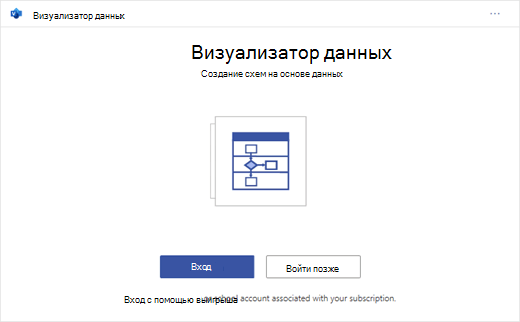
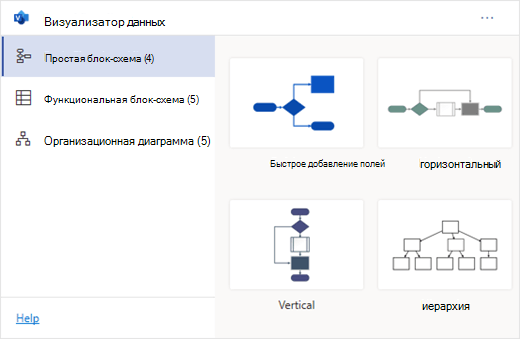
 .
.



 , чтобы просмотреть изменения.
, чтобы просмотреть изменения.